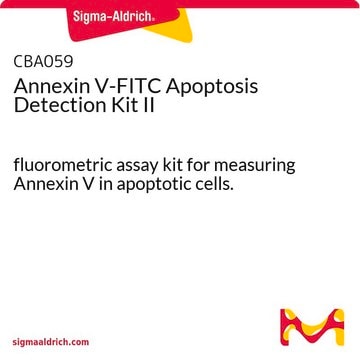Recommended Products
usage
sufficient for 60 cell suspensions
packaging
pkg of 1 kit
technique(s)
flow cytometry: suitable
application(s)
cell analysis
detection
detection method
fluorometric
shipped in
wet ice
storage temp.
2-8°C
Application
The greater incorporation of Br-dUTP results in a stronger signal by flow cytometry when detected using a fluorescein-labeled anti-BrdU antibody.Propidium iodide/RNase A solution is included in the kit to counterstain the total DNA. APOBRDU has been used in flow cytometry assay in human non–small cell lung cancer. APOBRDU has been used in cell cycle and apoptosis assay in HeLa cells, and in tunel assay human neuroblastoma cell lines.
Features and Benefits
Greater incorporation of Br-dUTP, resulting in improved detection than found by using biotin- or digoxigenin-conjugated dUTP or by using fluorochrome (fluorescein or BODIPY)-conjugated deoxynucleotides.
Packaging
The kit is shipped in two parts, both wet ice. Upon receipt, store APO-PART1 at −20 °C and APO-PART2 at 2-4 °C
Principle
Br-dUTP is incorporated more readily into the DNA fragments than deoxyuridine triphosphate labeled with larger dyes such as FITC, biotin or digoxigenin. One of the biological characteristics that defines apoptosis is the degradation of genomic DNA into fragments of 180-200 bp, commonly called "DNA laddering". The fragmentation creates a large number of 3′-hydroxyl sites at the DNA breaks. This property is used in the APO-BRDU kit to identify apoptotic cells by labeling the 3′-hydroxyl sites with bromodeoxyuridine triphosphate (Br-dUTP). Br-dUTP is enzymatically attached to the 3-hydroxyl sites of double- or single-stranded DNA by terminal transferase (TdT). Non-apoptotic cells do not incorporate Br-dUTP due to the lack of available 3-hydroxyl sites.
Kit Components Only
Product No.
Description
- Br-dUTP 480 μL
- Fluorescein PRB-1 antibody 300 μL
- Negative control cells 5 mL
- PI/RNase staining buffer 30 mL
- Positive control cells 5 mL
- Reaction buffer .6 mL
- Rinsing buffer 120 mL
- Terminal deoxynucleotidyl transferase (TdT) 45 μL
- Wash buffer 120 mL
See All (9)
Signal Word
Danger
Hazard Statements
Precautionary Statements
Hazard Classifications
Carc. 1B - Eye Irrit. 2 - Flam. Liq. 2 - Resp. Sens. 1 - Skin Sens. 1
Storage Class Code
3 - Flammable liquids
Flash Point(F)
55.4 °F
Flash Point(C)
13 °C
Certificates of Analysis (COA)
Search for Certificates of Analysis (COA) by entering the products Lot/Batch Number. Lot and Batch Numbers can be found on a product’s label following the words ‘Lot’ or ‘Batch’.
Already Own This Product?
Find documentation for the products that you have recently purchased in the Document Library.
Customers Also Viewed
Cdc7 is an active kinase in human cancer cells undergoing replication stress
Tenca P, et al.
The Journal of Biological Chemistry, 282(1), 208-215 (2007)
The novel lipophilic camptothecin analogue gimatecan is very active in vitro in human neuroblastoma: a comparative study with SN38 and topotecan
Di Francesco AM, et al.
Biochemical Pharmacology, 70(8), 1125-1136 (2005)
Cardenolide-induced lysosomal membrane permeabilization demonstrates therapeutic benefits in experimental human non-small cell lung cancers
Mijatovic T, et al.
Neoplasia, 8(5), 402-412 (2006)
X Li et al.
Cell proliferation, 28(11), 571-579 (1995-11-01)
In situ presence of numerous DNA strand breaks is a typical feature of apoptotic cells. Selective DNA strand break induction by photolysis (SBIP) at sites that contain incorporated halogenated DNA precursors has recently been proposed as a method of analysing
Xiangjun Sun et al.
Experimental and therapeutic medicine, 17(3), 2334-2340 (2019-03-15)
The present study aimed to elucidate the underlying mechanism of neuroepithelial cell transforming 1 (NET-1), a member of the Ras homolog gene family, in hepatocellular carcinoma (HCC). To determine the association between the expression of NET-1 and the proliferation and
Our team of scientists has experience in all areas of research including Life Science, Material Science, Chemical Synthesis, Chromatography, Analytical and many others.
Contact Technical Service










